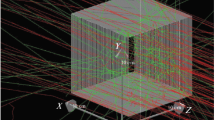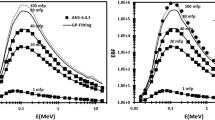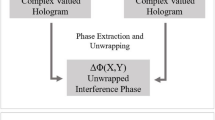Abstract
We have reviewed applicable ranges for attenuating media and off-axis distances regarding the high-energy X-ray spectra reconstructed via the Iwasaki–Waggener iterative perturbation method for 4–20 MV X-ray beams. Sets of in-air relative transmission data used for reconstruction of spectra were calculated for low- and high-Z attenuators (acrylic and lead, respectively) by use of a functional spectral formula. More accurate sets of spectra could be reconstructed by dividing the off-axis distances of R = 0–20 cm into two series of R = 0–10 cm and R = 10–20 cm, and by taking into account the radiation attenuation and scatter in the buildup cap of the dosimeter. We also incorporated in the reconstructed spectra an adjustment factor (f adjust ≈ 1) that is determined by the attenuating medium, the acceleration voltage, and the set of off-axis distances. This resulted in calculated in-air relative transmission data to within ±2 % deviation for the low-Z attenuators water, acrylic, and aluminum (Al) with 0–50 cm thicknesses and R = 0–20 cm; data to within ±3 % deviation were obtained for high-Z attenuators such as iron (Fe), copper (Cu), silver (Ag), tungsten (W), platinum (Pt), gold (Au), lead (Pb), thorium (Th), and uranium (U) having thicknesses of 0–10 cm and R = 0–20 cm. By taking into account the radiation attenuation and scatter in the buildup cap, we could analyze the in-air chamber response along a line perpendicular to the isocenter axis.

















Similar content being viewed by others
References
Mackie TR, Reckwerdt P, Papanikolaou N. 3-D photon beam dose algorithms. In: Purdy JA, Emami B, editors. 3-D radiation treatment planning and conformal therapy. Madison: Medical Physics Publishing Corporation; 1995.
Mackie TR, Reckwerdt P, McNutt T, Gehring M, Sanders C. Photon beam dose computations. In: Mackie TR, Palta JR, editors. Teletherapy: present and future. Madison: Advanced Medical Publishing; 1996.
Iwasaki A, Kimura S, Sutoh K, Kamimura K, Sasamori M, Komai F, Seino M, Terashima S, Kubota M, Hirota J, Hosokawa Y. A convolution/superposition method using primary and scatter dose kernels formed for energy bins of X-ray spectra reconstructed as a function of off-axis distance: a theoretical study on 10-MV X-ray dose calculations in thorax-like phantoms. Radiol Phys Technol. 2011;4:203–15.
Kimura S, Sutoh K, Kamimura K, Iwasaki A, Sasamori M, Komai F, Seino M, Terashima S, Kubota M, Hirota J, Hosokawa Y. A convolution/superposition method using primary and scatter dose kernels formed for energy bins of X-ray spectra reconstructed as a function of off-axis distance: comparison of calculated and measured 10-MV X-ray doses in thorax-like phantoms. Radiol Phys Technol. 2011;4:216–24.
Iwasaki A, Matsutani H, Kubota M, Fujimori A, Suzaki K, Abe Y. A practical method for estimating high-energy x-ray spectra using the iterative perturbation principle proposed by Waggener. Radiat Phys Chem. 2003;67:81–91.
Iwasaki A, Kubota M, Hirota J, Fujimori A, Suzaki K, Aoki M, Abe Y. Characteristic features of a high-energy x-ray spectra estimation method based on the Waggener iterative perturbation principle. Med Phys. 2006;33:4056–63.
Waggener RG, Blough MM, Terry JA, Chen D, Lee NE, Zhang S, McDavid WD. X-ray spectra estimation using attenuation measurements from 25 kVp to 18 MV. Med Phys. 1999;26:1269–78.
Ulmer W, Pyyry J, Kaissl W. A 3D photon superposition/convolution algorithm and its foundation on results of Monte Carlo calculations. Phys Med Biol. 2005;50:1767–90.
Loevinger R. A formalism for calculation of absorbed dose to a medium from photon and electron beams. Med Phys. 1981;8:1–12.
Japan Society of Medical Physics. Standard Dosimetry of absorbed dose in external beam radiotherapy (Standard Dosimetry 01). Tokyo: Tsusho-Sangyo-Kenkyu-Sha; 2006.
Hubbell JH. Photon mass attenuation and energy-absorption coefficients from 1 keV to 20 MeV. Int J Appl Radiat Isot. 1982;33:1269–90.
Acknowledgments
One of the authors, A. Iwasaki, is grateful to Mr. H. Mikami for his helpful advice and timely guidance throughout this study. Part of this work was performed by Ms. R. Mori and Mr. S. Nakano for their graduation studies at the Hirosaki University Graduate School of Health Sciences. The authors would like to thank the referees for careful reading of the manuscript and for giving useful comments.
Author information
Authors and Affiliations
Corresponding author
Appendices
Appendix 1: The \( {\varvec{{\mu}_{\bf{{cap}}}^{\bf{{eff}}}} }\) factor
The \( \mu_{\text{cap}}^{\text{eff}} \) factor (Eq. 14) for a given X-ray beam should be determined around the region forming the maximum cap-absorbed dose under electronic equilibrium. The chamber generally detects the primary and scattered doses generated in the buildup cap. When f cap = 1 in Eq. 14, \( \mu_{\text{cap}}^{\text{eff}} (E) = (\mu (E))_{\text{cap}} , \) with the result that any scattered photons produced in the buildup cap do not contribute to the chamber readings. When f cap = 0 in Eq. 14, \( \mu_{\text{cap}}^{\text{eff}} (E) = (\mu_{\text{en}} (E))_{\text{cap}} , \) with the result that all scattered photons produced in the buildup cap do contribute to the chamber readings.
Let ρcap denote the mass density of the buildup cap material. Around the region forming the maximum cap-absorbed dose, the value of \( \mu_{\text{cap}}^{\text{eff}} (E)H_{\text{cap}}^{\text{eff}} \) in Eq. 13 can be relatively small (also by taking into account the relative magnitude of Ψ0 regarding E). Then, with the use of Eq. 14, we can formulate the following approximate expression:
On the right side of Eq. 27, it can be understood that, for a unit of energy fluence, the second term expresses the energy loss as the primary cap collision kerma component, and the third term the energy loss as the scattered photon dose component. It should also be noted that the f cap factor should vary with the size and shape of the buildup cap and with the X-ray beam size and position for the buildup cap (Fig. 1). Accordingly, it can be understood that Eq. 14 is reasonable around the region forming the maximum cap-absorbed dose under electronic equilibrium.
Appendix 2: The correlation factor
For a representative energy E N (N = 1 − N max), we take Y K = log[Φdisc (E N , R K )] as a function of off-axis distance R K (K = K min − K max), where Φdisc (E N , R K ) is the normalized photon fluence as a function of E N at R K (see Eq. 12). For E N , the square of the correlation factor (r N ) between Y K and R K values is calculated as
where r 2 N ≤ 1 with
When the denominator of Eq. 28 has a value less than 10−3, the calculation of r 2 N is unstable. Such values are excluded from the calculation of Index-1 (Eq. 23). Therefore, Index-1 is expressed with use of the number \( \left( {N_{\max }^{\prime } } \right) \) of the adopted r 2 N data \( \left( {N_{\max }^{\prime } \le N_{\max } } \right) \).
About this article
Cite this article
Iwasaki, A., Kimura, S., Sutoh, K. et al. Reconsideration of the Iwasaki–Waggener iterative perturbation method for reconstructing high-energy X-ray spectra. Radiol Phys Technol 5, 248–269 (2012). https://doi.org/10.1007/s12194-012-0160-7
Received:
Revised:
Accepted:
Published:
Issue Date:
DOI: https://doi.org/10.1007/s12194-012-0160-7




